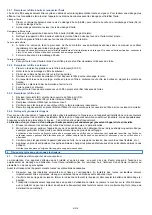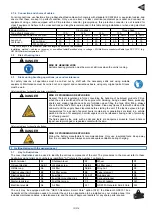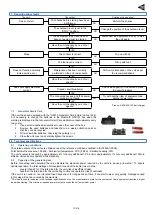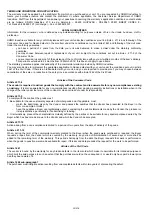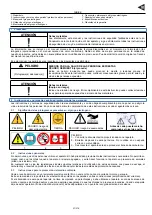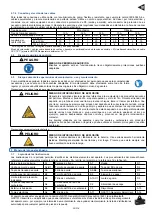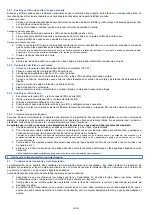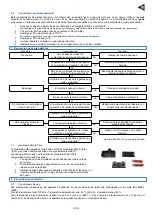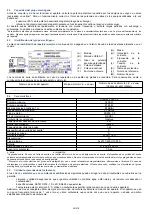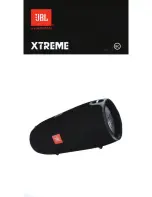
2.7.4 Connection and choice of cables
For all connections, use flexible, strong rubber-sheathed cables which comply with standard IEC 60245-4 or equivalent cables, and
ensure that these are kept in perfect condition. Only use one item of class I electrical equipment per socket and connect up
equipment using a cable equipped with a PE protective conductor (green/yellow); this protective conductor is not required for
class II equipment. Adhere to the cross sections and lengths recommended in this table during installation or when using electrical
extensions.
Equipment type:
Single-phase
Three-phase
Type of unit connector:
10 A
16 A
32 A
10 A
16 A
Recommended cable cross section:
mm²
AWG
mm²
AWG
mm²
AWG
mm²
AWG
mm²
AWG
0 to 50 m
4
10
6
9
10
7
1.5
14
2.5
12
51 to 100 m
10
7
10
7
25
3
2.5
12
4
10
Length of
cable used
101 to 150 m*
10
7
16
5
35
2
4
10
6
9
*This cable length is the maximum permitted length, and must not be exceeded.
Installation method = cables on raceway or non-drilled tablet/Permitted drop in voltage = 5%/Multi-core conductors/Cable type PVC 70°C (e.g.
H07RNF)/Ambient temperature =30°C.
2.8
Risk of hearing loss
DANGER
RISK OF HEARING LOSS
Suitable hearing protection must be worn at all times when the unit is running.
2.9
Risks during handling operations, use and maintenance
For safety reasons, all operations must be carried out by staff with the necessary skills and using suitable
equipment. Maintenance must be carried out on a regular and conscientious basis, using only original parts. Gloves
must be worn.
Safety guidelines for handling petroleum products:
DANGER
RISK OF POISONING OR EXPLOSION
Respect the local regulations in force concerning the handling of petroleum products. Fill up
when the unit is switched off and the engine cold. Smoking, using a naked flame, producing
sparks and making telephone calls are forbidden when filling the tank. After filling, always
check that the tank's filler cap is properly tightened. Clean any traces of fuel with a clean cloth
and wait until the vapors have dispersed before starting the unit. If the fuel is exposed to high
temperatures for a period of several hours (containers or generating set stored in a vehicle
parked in the sun, for example), harmful vapors could be released causing a risk of poisoning
or of feeling unwell.
The fluids used by the units, such as oils and fuels, are dangerous products. Never inhale or
ingest; avoid prolonged or repeated contact with the skin.
Safety guidelines for handling batteries:
DANGER
RISK OF POISONING OR EXPLOSION
Follow the battery manufacturer's recommendations. Only use insulated tools. Keep away
from fire or naked flames. Always ensure adequate ventilation during charging.
3 Getting started with the generating set
3.1
Key to illustrations
The cover illustrations can be used to identify the various components of the unit. The procedures in the manual refer to these
illustrations using letters and numbers as identifiers: "A1" refers to the number 1 on figure A.
Earth terminal
A1
Shutdown lever
A7
Wheel
D1
Oil level dipstick
A2-B1
Oil drain screw
A8-B4
Air filter cover
D2
Oil filler cap
A3
Oil filter
A9-B6
Wing nut
D3
Dipstick upper limit
B2
Oil filter screw
B5
Paper element
D4
Dipstick lower limit
B3
Fuel filter
A10-C1
Rubber seal
D5
Fuel tank cap
A4
Fuel filter mounting clips
C2
Exhaust silencer
A12
Starter-recoil reel
A5
Fuel filter screw
C3
Circuit breakers
A13
Electrical sockets
A6
Air filter
A11
GSC101-Generator Smart Care
A14
The unit may be equipped with the "GS101-Generator Smart Care" option (A14): the Bluetooth GSC101 box
transmits all the information needed to monitor the unit to an application to be installed on your mobile phone; this
includes maintenance dates, a maintenance aid, and the map of approved resellers for any spare parts required.
13/218
Содержание SDMO DIESEL 4000 C5
Страница 2: ...A 11 2 7 STOP 1 3 4 5 8 9 10 12 6 13 14 ...
Страница 3: ...B C 2 1 4 5 6 3 1 3 2 ...
Страница 4: ...D FRANCE 0 806 800 107 Prix appel 5 2 1 3 4 ...








